Summary
Drinking water for animals is a feedstuff and the most important nutrient. A shortage of water in the
organism quickly leads to a decrease in feed consumption, a reduction in growth, disturbances in
metabolism and finally to death. Biological and chemical ingredients can affect the health of the
animals and the consumer.
The importance of drinking water for the performance and health of the animals is often underestimated. The article addresses the issue of regulating the water balance of the animals, the water
requirements, drinking system technology, water quality and the maintenance and monitoring thereof,
with particular emphasis being placed of broiler chickens. It further deals with the possibility of administering various substances and preparations via drinking water. Knowledge gained at a workshop
on the subject „Water supply in poultry farming – a key factor for health and performance“ is included
in the article. The workshop with international guests was organised by Lohmann Animal Health and
took place in October 2009.
Introduction
Water is a feedstuff and the most important nutrient for animals (Kamphues et al., 2002; 2007). For this reason particular attention must be paid to satisfying the animals’ needs, to water line technology and to the quality of the drinking water. If water is not provided in sufficient quantity and quality this can lead to drops in performance and even endanger animal health. Water quality is not only significant for the health of the animals but, in the case of food-supplying animals, also for the protection of consumers against zoonotic pathogens, e.g. Salmonella spp. and Campylobacter spp. and other harmful substances. In October 2009 Lohmann Animal Health GmbH & Co. KG held a two-day workshop on the subject of „Water supply in poultry farming – a key factor for health and performance“. The aim of the workshop was to gather information on the water supply of broiler chickens whereby the knowledge gained at the workshop should be passed on to others.Regulating the water balance
Water is needed as a diluent, transport medium and for maintaining internal cell pressure and body temperature. Water is excreted primarily via urine and faeces but also in the form of steam via the skin and respiratory tract. In addition to drinking water, water is also available to the animals via feedstuffs and via metabolic water generated by metabolic processes. Water uptake is triggered off by the feeling of thirst. Thirst is triggered off by an increased osmolality of body fluids (fig. 1). Dehydration (exsiccosis) is a hypertensive hypovolumaemia to which an intra-cellular dehydration is connected. The centre of thirst is situated in the hypothalamus. In the event of shortage of fluid the antidiuretic hormone
Figure 1: Regulating the water supply
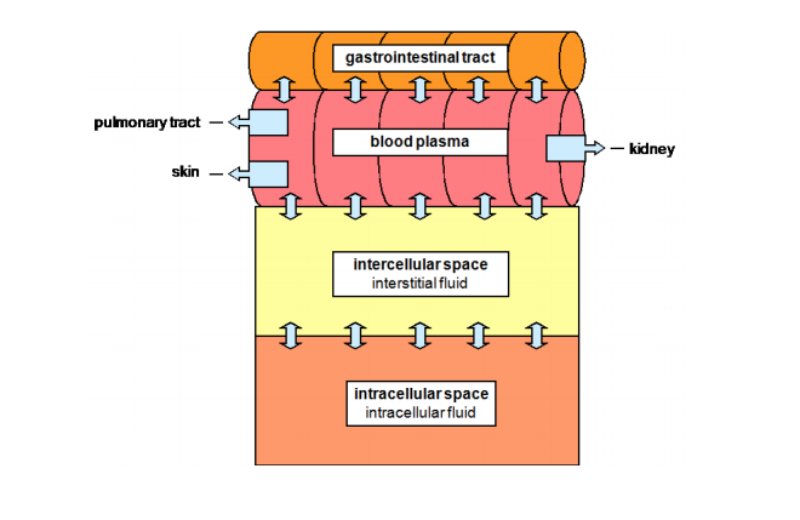
(ADH) is released. This causes the kidneys to retain more water and excrete less. In the event of water excess the release of the hormone ADH and the feeling of thirst are inhibited and thus the amount of water excreted by the kidneys increased. The concentration of sodium in the blood plasma in connection with the renin-angiotensin-aldosterone system is also involved in the regulation of water supply. A reduction in sodium concentration leads to a reduction in the plasma volume. The reninangiotensin-aldosterone system is thus set into operation. It results in an increased resorption of sodium in the kidneys and an increase in plasma volume.
The water taken up is resorbed in the small intestine via osmotic activity. 70% of the body mass of broiler chickens is water (Wilson, 2009). Of this around 50 % is located in the intracellular space and 20 % in the extracellular space which is subdivided into intravasal space and extravasal space (fig. 2). The exchange of water between the fluid spaces is caused by differences in concentration with the aim of achieving osmotic balance.
Figure 2: Fluid spaces
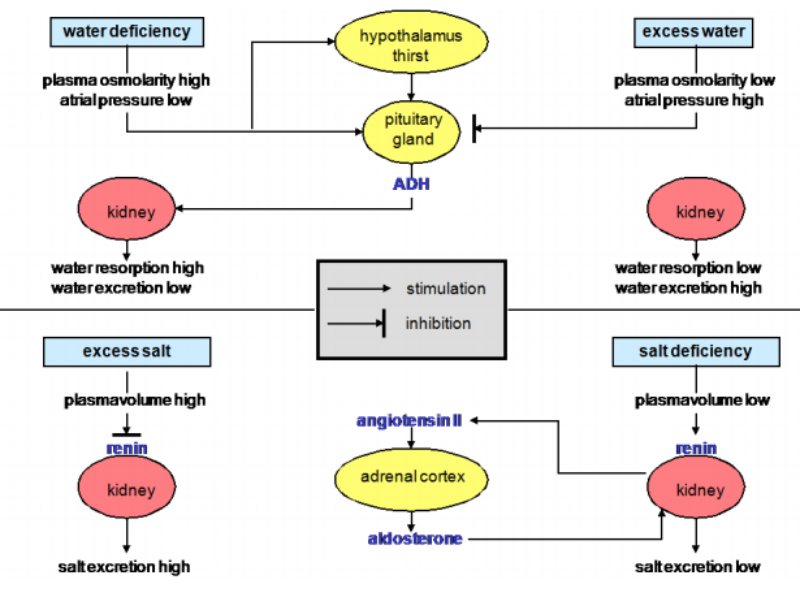
Water requirements
The animals must be supplied daily with a quantity and quality of water according to their needs (table 1). Water deficiency results in a reduction in feed uptake and thus in reduced weight gain, to dehydration / exsiccosis and eventually to death if more than one tenth of water content is lost. Growing animals take up more water than they excrete (Wilson, 2009).
There is particular correlation between the amount of feed taken up (dry mass) and water consumption (Langhans et al., 1995). Furthermore, the ambient temperature and feed composition also have an influence on water consumption. The water requirements of broiler chickens expressed in ml per animal and day are calculated on the base of the age of the animals multiplied by factor 6 at optimum ambient temperatures and factor 7 at high temperatures (Wilson, 2009). At temperatures over 20 °C the water requirements rise by 6 % per °C. Not only the ambient temperature but also the temperature of the water itself influences water consumption. Water temperature below 5 °C and above 44 °C leads to lower consumption (Wilson, 2009). Of course the taste of water also influences water consumption.
First indicators of an inadequate water supply are a decrease in feed consumption and performance. The causes can be broken self-drinkers, broken or blocked water lines and insufficient flow rates. A flow rate of 50 to 80 ml per nipple and minute are required for an adequate water supply – this corresponds to a handful of water in 10 s (Wilson, 2009).
There is also a correlation between the amount of water taken up and the wetness of the litter. Attention must be paid that the water supply is not decreased just to prevent the litter material from becoming too wet.
Table 1: Drinking water requirements of broiler chickens (KTBL-Heft 83, 2009)
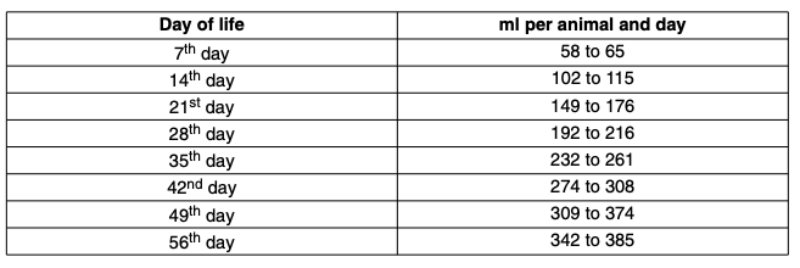
Origin of the drinking water
Drinking water for broiler chickens comes either from the communal network or from the farm’s own well. Until it is fed into the farm water lines, the water from the communal network is of drinking water quality which is guaranteed by prescribed monitoring and treatment. The quality of the water from the farm’s own well corresponds to the quality of groundwater if it is not treated prior to being fed into the farm and/or drinking system. Based on the results of water analyses the decision must be made whether any treatment is necessary.Once the water has been fed into the farm, in particular into the drinking lines, changes can occur meaning that the quality of the water fed into the system does not correspond to the quality of the water taken up by the animals. Changes occurring to the water after it has been fed into the water lines of the farm can have a number of reasons, e.g. resulting from medication or additives being added to the water or due to contamination of the drinking system following maintenance work (Seemann, 2009).
Drinking water system
The first part of the drinking water system is the connection to the communal network or to the own supply system (farm’s own well). This is followed by the pipe to the houses in which the equipment for water preparation and dosing equipment for the addition of medication is located. From there the water is directed into the houses where the height-adjustable drinking water lines with nipple drinkers are installed. There are nipple drinkers with and without drip cup. There should be 1 drinker for every 12 to 15 animals and the distance between the drinkers should not be more than 2 to 3 m (Wilson, 2009). An important factor is the height of the nipple drinkers above the litter which must be adapted to the size of the animals. Nipple-drinker systems are low-pressure systems. There is a reduction in pressure from 3 to 0.01 to 0.04 bar (Meyer, 2009). It should be avoided that the water stands for longer periods in the water lines which happens in the case of low consumption (e.g. after placement) as this encourages the precipitation of ingredients, the multiplication of bacteria and the formation of biofilm (Kamphues et al., 2007). Biofilms are ecosystems of microorganisms of different families which cohabit in an extracellularly formed polysaccharide-protein layer and are thus difficult to combat using antimicrobial agents (Eecke, 2009; Watkins, 2009).Even if the water is primarily of good quality there is a danger of contamination of the drinking water in the event of technical defects in the drinker system. Open drinkers must thus be protected against contamination. During the continual monitoring of the drinker systems the following aspects must be observed (Müller and Schlenker, 2007):
Drinking water quality
Water quality is determined by the presence of microorganisms which cause disease and of substances which are toxic or influence the taste.There are no legal requirements for the quality of drinking water in animal husbandry such as those for the quality of drinking water for human consumption. Drinking water for animals in the EU is incorporated into the term “feedstuffs” (Regulation (EC) no. 178/2002 of the European Commission and the Council of 28th January 2002). In order to support the objectives in this regulation the Feed Hygiene Regulation (regulation (EC) no. 183/2005 of the European Commission and the Council dd.
12th January 2005) was enacted. The stipulations laid down therein came into force on 1st January 2006. According to this the drinking water for animals must be of such quality that it is suitable for the animals concerned. The legislator restricts the legal requirements to general safety requirements.
However, it is advisable to orientate the requirements for animal drinking water to the Drinking Water Ordinance (2001). Drinking water for animals should be free from pathogens and free from harmful substances in toxic concentrations and should also have a pleasant smell and taste. Pathogens and harmful substances do not only affect the health of the animals but also the sanitary harmlessness of the food produced from them. In addition to a variety of recommendations for drinking water quality (e.g. Müller and Schlenker, 2007; Eecke, 2009) there is also a framework issued by the Federal Ministry for Nutrition, Agriculture and Consumer Protection (BMELV, 2007) on the legal evaluation of water as a feedstuff. The title is “The hygienic quality of drinking water for animal husbandry” („Hygienische Qualität von Tränkwasser“).
This requires the microbiological quality of water fed into the system to be free from Salmonella and Campylobacter and as far as possible free from Escherichia coli. The colony count of aerobic bacteria is used as the orientation value for measuring microbial contamination (table 2). These orientation values should not only apply to the water fed into the system, but above all to the water outlets in the houses. The imprecise indication for Escherichia coli should be interpreted in such a way that not more than 10 cfu are present in 100 ml water.
The BMELV has issued orientation values for the evaluation of physico-chemical parameters of drinking water taking food and feed safety into consideration (table 3). Physico-chemical factors can lead not only to damage to health but also to changes in the taste of water and deposits in the water pipes which on the one hand promotes the formation of biofilm and on the other hand can result in the animals taking up an insufficient quantity of water.
Knowledge on the meaning of physico-chemical parameters for the health and performance of broiler chickens is incomplete. A pH-value of water of below 5.9 should be detrimental to performance; a pH value over 8 reduces the disinfectant effect of chlorine (Watkins, 2009). High concentrations of minerals
Table 2: Reference values of the Federal Ministry for Nutrition, Agriculture and Consumer
Protection (BMELV, 2007) for the evaluation of the biological quality of drinking
water
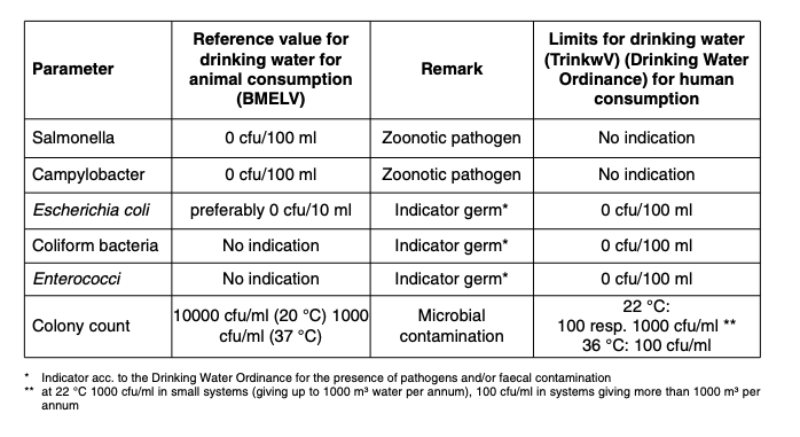
in hard to very hard water (range of hardness III and IV) due to calcium- and magnesium carbonate and sulphates, nitrates or chlorides lead to precipitations in the water lines and impairment to the function of the nipple drinkers (Kamphues et al., 2007; Watkins, 2009; Wilson, 2009). Precipitations on the walls of the pipes not only restrict the lumen, but also promote the colonization of bacteria and other microorganisms and thus the formation of biofilm. The electrical conductivity is determined by the concentration of electrolytes. Values above 500 µS/cm are indicators for depositions of sodium, potassium and chloride (Kamphues et al., 2007). A content of sodium chloride below 1000 mg/l does not cause any problems. Values exceeding this level reduce feed consumption. Iron promotes bacterial growth. Particularly when using a farm’s own well, the groundwater can be contaminated with fertilizer and liquid manure containing nitrate and nitrite which can lead to reduced weight gain (Watkins, 2009). Complexing substances in the water can influence the efficacy of medication and vaccines applied via the drinking water (Kamphues et al., 2007).
Treatment of drinking water
Particularly when using a farm’s own well the treatment of the drinking water can be necessary. The main treatments are the filtration of the water, softening and reducing the germ count. Cleaning and disinfection of the water lines to remove deposits (precipitations) and biofilm also belong to water treatment.There are filters which can be backwashed and replacement filters. Filtration is necessary to remove particles of dirt such as sand and to remove iron and manganese oxide following the oxidation of iron and manganese (de-ironing, demanganisation). Softening is required less in cold water pipes than in warm water pipes and is mainly carried out using ion-exchange resin. If the germ count is too high (in excess of the values shown in table 2) disinfection should be carried out by adding e.g. chlorine compounds or active oxygen. Only products approved in accordance with the Drinking Water Ordinance or with feed laws or with the Biocide Regulation (2002) should be used for the purpose (Kamphues et al., 2009). UV-radiation can also be used for disinfection (Meyer, 2009).
Table 3: Reference values of the Federal Ministry for Nutrition, Agriculture and Consumer
Protection (BMELV, 2007) for the evaluation of the physico-chemical quality of
drinking water
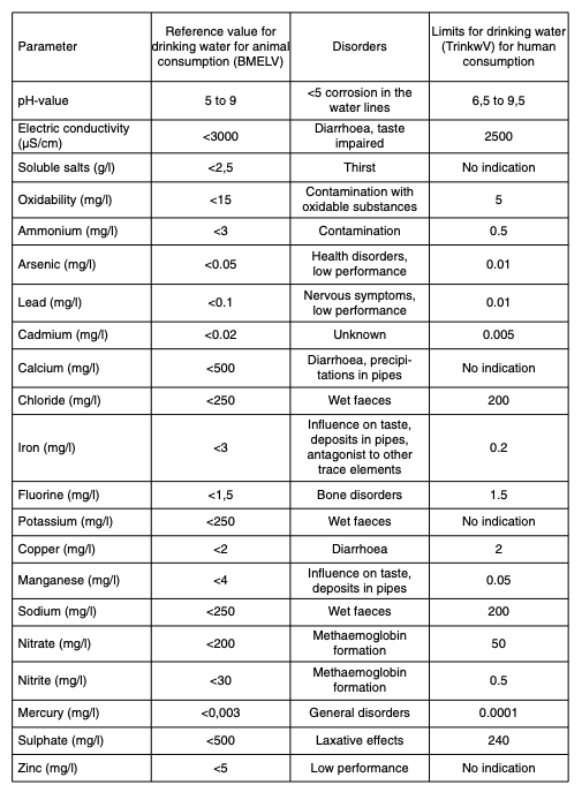
A particular problem is the prevention and removal of deposits, air pockets and biofilms in the water lines. The lines should be flushed up to three times a week with 1.5 to 3 bar pressure, whereby automatic equipment is available for this purpose (Meyer, 2009; Wilson, 2009). Thorough cleaning and disinfection by flushing and/or rinsing the water lines which have been emptied of drinking water and are open at the end must take place during the service period as preparation for placement with new chicks.
Monitoring drinking water quality
If the water is taken from the public network the quality of the drinking water is only guaranteed up to the point where the water is fed into the farm (house installation). If wells are available in an animal production unit solely for providing drinking water for the animals, monitoring of water quality is not prescribed. Thus, on using farm’s own wells there is a danger of contaminating the flock with microorganisms and harmful substances. It is thus recommended that well water be analysed at least once a year prior to feeding it into the farm system. Both drinking water from the public network and water from the farm’s own well can become contaminated in the water lines of the farm or house, e.g. due to open supply tanks, due to the addition of medication and vaccines and by the nipple drinkers. Water can stagnate in the water lines during the service period thus leading to high bacterial counts and biofilm formation particular at high temperatures. Biofilms can come loose and contaminate the water with huge amounts of microorganisms, which can also include pathogens. Biofilms, however, can also secrete metabolic products which have a negative effect on the smell and taste of the drinking water. It is therefore important to differentiate between the quality of the drinking water fed into the supply system and the quality of the water taken up by the animals.The quality of the drinking water at the end of the drinker lines in the house should be determined once or twice a year. In case of strong deviation from the drinking water quality, appropriate samples should be taken to clarify whether the contamination is being caused in the farm and at what points, or whether it is being brought into the farm from the farm’s own well. An inspection of the microbiological quality of the drinking water should also be carried out following cleaning and disinfection of the drinker system.
During sampling care must be taken that the results are not falsified due to incorrect sampling. Before taking a sample the water must run for 5 minutes. A min. of 250 ml is needed for microbiological analyses, whereby the sample should be sterile if at all possible (flame the tap) and filled into a sterile bottle to prevent any secondary contamination of the water. To clarify deviations in drinking water quality or to check the cleaning and disinfection of the drinker system the sampling, place of sampling and time of sampling must be adapted to the matter concerned. For chemical analyses 2 l of water must be brought cooled to the laboratory as quickly as possible and kept in the refrigerator until the analysis is carried out. The analysis should take place within 6 hours if possible.
Various test instruments are available for on-site inspection of the quality of drinking water for human and animal consumption.
Administration of substances via drinking water
In 2009 BMELV published a guideline on the oral application of veterinary drugs for productive livestock via feed or drinking water. Upon each treatment of food-producing animals the efficacy of the use of veterinary drugs, the prevention of undesired side-effects, user safety, food safety, consumer protection, animal welfare and the prevention of spreading antibiotic resistance must be taken into consideration when making the decision. The veterinarian must ascertain that the oral application of the required dose can be ensured for each animal. For administration via drinking water only those drugs may be used which are approved for this type of application. The pyhsico-chemical properties of the water must be taken into consideration (e.g. water hardness, pH-value, iron- and calcium content).In order to prevent any impairment to the drugs and in particular to live vaccines certain demands must be made on the quality of the drinking water – drinking water suitable for human consumption should be used. The entry of unused medicated water into the environment must be prevented to avoid any risks of resistance. The dosing apparatus must be in technically good order. The veterinarian must provide the livestock owner with written instructions on the administration of oral drugs.
Vaccines, antibiotics, minerals, vitamins, amino acids, phytopreparations and organic acids can be administered via water. By acidifying the drinking water Thorp (2009) achieved improved weight gain and lower mortality in broiler chickens. Thorp further reported about similar results following administration of health products containing vitamins, minerals, amino acids, glucose, organic acids and herbal substances via drinking water. The administration of vitamin C is said to reduce heat-induced stress during catching.
Biozidverordnung (2002): Verordnung über die Zulassung von Biozidprodukten und sonstige chemikalienrechtliche Verfahren zu Biozid-Produkten und Biozid-Wirkstoffen (Biozid-Zulassungs-verordnung-ChemBiozid ZulV), BGBl I 2002, 2514-2524.
BMELV (2007): Hygienische Qualität von Tränkwasser. Orientierungsrahmen zur futtermittel-rechtlichen Beurteilung.
BMELV (2009): Leitfaden des BMELV vom 19. Juni 2009 über die orale Anwendung von Tierarznei-mitteln im Nutztierbereich über das Futter oder das Trinkwasser.
van Eecke, J. (2009): Biofilm in water systems of poultry houses. Lohmann Animal Health, workshop „Water supply in poultry farming – a key factor for health and performance“, Cuxhaven, 20-21 October 2009.
Kamphues, H. and I. Schulz, (2002): Praxisrelevante Aspekte der Wasserversorgung von Labor- und Nutztieren. Übers. Tierernährung, 30, 65-107.
Kamphues, J., R. Böhm, G. Flachowsky, M. Lahrssen-Wiederholt, U. Meyer and H. Schenkel (2007): Empfehlungen zur hygienischen Beurteilung von Tränkwasser für lebensmittel-liefernde Tiere unter Berücksichtigung der gegebenen rechtlichen Bedingungen. Landbauforschung Völkenrode, 57, 255-272.
KTBL-Heft 83 (2009): Wasserversorgung in der Geflügelhaltung. Kuratorium für Technik und Bauwesen in der Landwirtschaft. Langhans, W., R. Rossi and E. Schürrer (1995): Relationship between feed and water intake in ruminants: digestion, metabolism, growth and resorption. Proc. Soc. Nutr. Physiol. 3, 199-216.
Meyer, W. (2009): Water systems technology for poultry. Lohmann Animal Health, workshop „Water supply in poultry farming – a key factor for health and performance“.
Müller, W. and G. Schlenker (2007): Kompendium der Tierhygiene. 3. Auflage, Lehmanns Media, Berlin.
Seemann, G. (2009): Water supply under extreme hygiene requirements. Lohmann Animal Health workshop „Water supply in poultry farming – a key factor for health and performance“.
Thorp, B. (2009): Administration of substances via drinking water systems. Lohmann Animal Health, workshop „Water supply in poultry farming – a key factor for health and performance“.
TrinkwV (2001): Verordnung über die Qualität von Wasser für den menschlichen Verbrauch vom 21. Mai 2001 (Trinkwasserverordnung-TrinkwV) , BGBl I 2001, 959 –969.
Verordnung (EG) Nr. 178/2002 zur Festlegung der allgemeinen Grundsätze und Anforderungen des Lebensmittelrechts, zur Errichtung der Europäischen Behörde für Lebensmittelsicherheit und zur Festlegung von Verfahren zur Lebensmittelsicherheit vom 28. Januar 2002. Amtsblatt der Europäischen Gemeinschaft: Rechtsvorschriften 2002 (L31) vom 1.2.2002.
Verordnung (EG) Nr. 183/2005 des Europäischen Parlaments und des Rates vom 12. Januar 2005 mit Vorschriften zur Futterhygiene. Amtsblatt der Europäischen Gemeinschaft: Rechtsvorschriften 2005 (L 35) vom 8.2.2002.
Watkins, S. (2009): Water quality in poultry farming. Lohmann Animal Health, workshop „Water supply in poultry farming – a key factor for health and performance“.
Wilson, M. (2009): Water management in broilers. Lohmann Animal Health, workshop „Water supply in poultry farming – a key factor for health and performance“.







